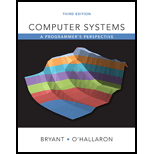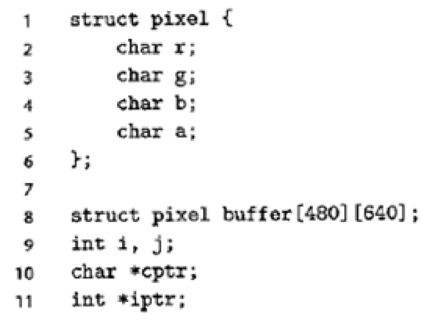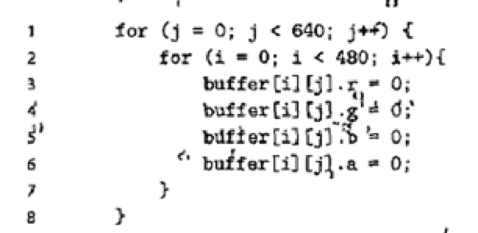
You are writing a new 3D game that you hope will earn you fame and fortune. You are currently working on a function to blank the screen buffer before drawing the next frame. The screen you are working with is a 640 x 480 array of pixels. The machine you are working on has a 64 KB direct-mapped cache with 4-byte lines The C structures you are using are as follows:

Assume the following:
- size of(char) = 1 and size of(int) = 4.
Homework Problem
- buffer begins at memory address 0.
- The cache is initially empty.
- The only memory accesses are to the entries of the array buffer. Variables l, j, cptr, and iptr are stored in registers.
What percentage of writes in the following code will miss in the cache?

Want to see the full answer?
Check out a sample textbook solution
Chapter 6 Solutions
Computer Systems: A Programmer's Perspective Plus Mastering Engineering With Pearson Etext -- Access Card Package (3rd Edition)
Additional Engineering Textbook Solutions
Java: An Introduction to Problem Solving and Programming (8th Edition)
Computer Science: An Overview (13th Edition) (What's New in Computer Science)
SURVEY OF OPERATING SYSTEMS
Java How to Program, Early Objects (11th Edition) (Deitel: How to Program)
Modern Database Management
Web Development and Design Foundations with HTML5 (8th Edition)
- When the FCC added Color Television to the Industry Standards, they went with the system developed in the 1940s by Peter Goldman for CBS. Question 15 options: True False Part of the reason that many critics disliked 1950s gameshows was the fact that gameshows offered one of the few opportunities to see unscripted interactions with "real" (average/non-famous) people on television. Question 16 options: True False The Andy Griffith Show is an example of the "rural revival" shows that become enormously popular on 1960s American television. Question 19 options: True False During the Network Era, the hours before primetime each day were exclusively devoted to locally-produced programming, not programming dictated by an affiliate station's parent network. Question 20 options: True Falsearrow_forwardAlthough color television was not added to the industry standard until 1956, CBS had been broadcasting selected special events in color as early as 1950. Question 1 options: True False Two key factors in creating the Network Era of American television were the FCC licensing freeze and ______________. Question 4 options: The Quiz Show Scandals Habitual Viewing Operation Frontal Lobes Drop-In Viewing Least Objectionable Programming was designed to embrace the public service-oriented vision of using television to elevate mass culture and enrich viewers. Question 6 options: True False By the end of the 1950s, all three remaining networks (NBC, CBS, & ABC) were broadcasting their entire nightly programming schedule in full color. Question 9 options: True Falsearrow_forward7. See the code below and solve the following. public class Test { public static void main(String[] args) { int result = 0; } result = fn(2,3); System.out.println("The result is: + result); // fn(x, 1) = x // fn(x, y) = fn(x, y-1) + 2, when y>1 public static int fn(int x, int y) { if (x <= 1) return x; else return fn(x, y-1) + 2; } } 7-1. This program has a bug that leads to infinite recursion. Modify fn(int x, int y) method to fix the problem. (2 point) 7-2. Manually trace the recursive call, fn(2,3) and show the output (step by step). (2 point) 7-3. Can you identify the Base Case in recursive method fn(int x, int y)? (1 point)arrow_forward
- 6. See the code below and solve the following. import java.io.*; public class DataStream { } public static void main(String[] args) } DataOutputStream output = new DataOutputStream(new FileOutputStream("temp.dat")); output.writeUTF("Book1"); output.writeInt(85); output.writeUTF("Book2"); output.writeInt(125); output.writeUTF("Book3"); output.writeInt(70); output.close(); // ToDo: Read all data from temp.dat and print the data to the standard output (monitor) 6-1. This program has a compile error, and the message is “Unhandled exception type FileNotFoundException". How do you fix this error? (1 point) 6-2. Is FileNotFoundException a checked exception or an unchecked exception? (1 point) 6-3. What is the difference between checked exception and unchecked exception? (1 point) 6-4. Please complete the above program by reading all data from temp.dat and print the data to the standard output (monitor) by using System.out.print, System.out.println or System.out.printf method. (2 points)arrow_forwardWrite a program that reads a list of integers from input and determines if the list is a palindrome (values are identical from first to last and last to first). The input begins with an integer indicating the length of the list that follows. Assume the list will contain a maximum of 20 integers. Output "yes" if the list is a palindrome and "no" otherwise. The output ends with a newline. Hints: - use a for loop to populate the array based on the specified size (the first number entered) - use a for loop to check first value with last value, second value with second from end, etc. - if the values do not match, set a Boolean variable to flag which statement to output (yes or no) Ex: If the input is (remember to include spaces between the numbers): 6 1 5 9 9 5 1 the output is: yes Ex: If the input is: 5 1 2 3 4 5 the output is: C++ codingarrow_forwardDesign and draw a high-level "as-is" process diagram that illustrates a current process related to a product or service offered through the SSDCI.gov database.arrow_forward
 Systems ArchitectureComputer ScienceISBN:9781305080195Author:Stephen D. BurdPublisher:Cengage Learning
Systems ArchitectureComputer ScienceISBN:9781305080195Author:Stephen D. BurdPublisher:Cengage Learning C++ for Engineers and ScientistsComputer ScienceISBN:9781133187844Author:Bronson, Gary J.Publisher:Course Technology Ptr
C++ for Engineers and ScientistsComputer ScienceISBN:9781133187844Author:Bronson, Gary J.Publisher:Course Technology Ptr New Perspectives on HTML5, CSS3, and JavaScriptComputer ScienceISBN:9781305503922Author:Patrick M. CareyPublisher:Cengage Learning
New Perspectives on HTML5, CSS3, and JavaScriptComputer ScienceISBN:9781305503922Author:Patrick M. CareyPublisher:Cengage Learning EBK JAVA PROGRAMMINGComputer ScienceISBN:9781337671385Author:FARRELLPublisher:CENGAGE LEARNING - CONSIGNMENTProgramming Logic & Design ComprehensiveComputer ScienceISBN:9781337669405Author:FARRELLPublisher:Cengage
EBK JAVA PROGRAMMINGComputer ScienceISBN:9781337671385Author:FARRELLPublisher:CENGAGE LEARNING - CONSIGNMENTProgramming Logic & Design ComprehensiveComputer ScienceISBN:9781337669405Author:FARRELLPublisher:Cengage C++ Programming: From Problem Analysis to Program...Computer ScienceISBN:9781337102087Author:D. S. MalikPublisher:Cengage Learning
C++ Programming: From Problem Analysis to Program...Computer ScienceISBN:9781337102087Author:D. S. MalikPublisher:Cengage Learning





